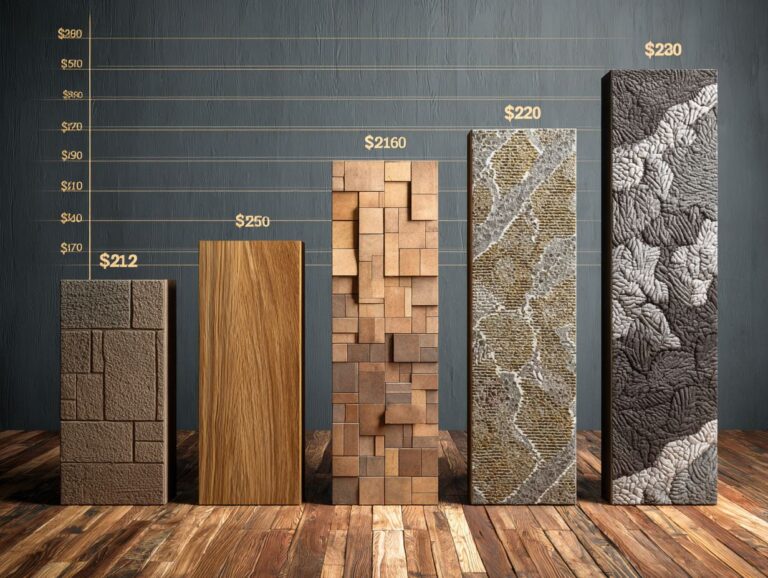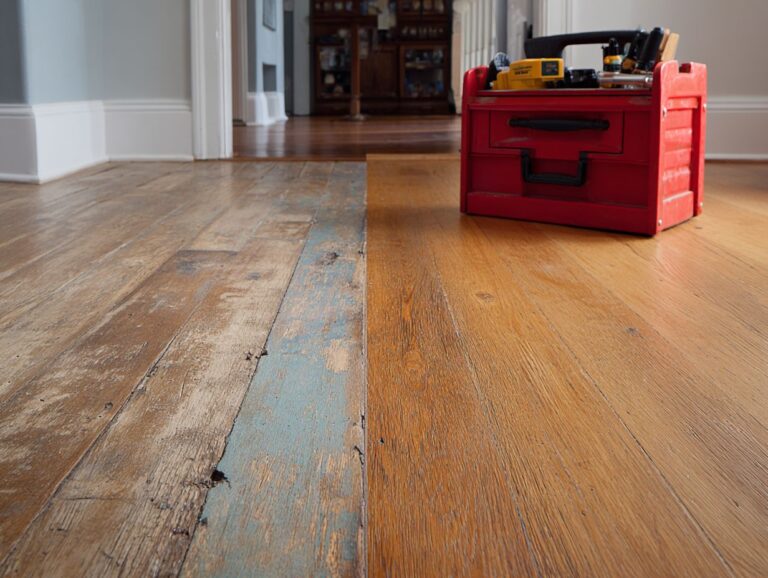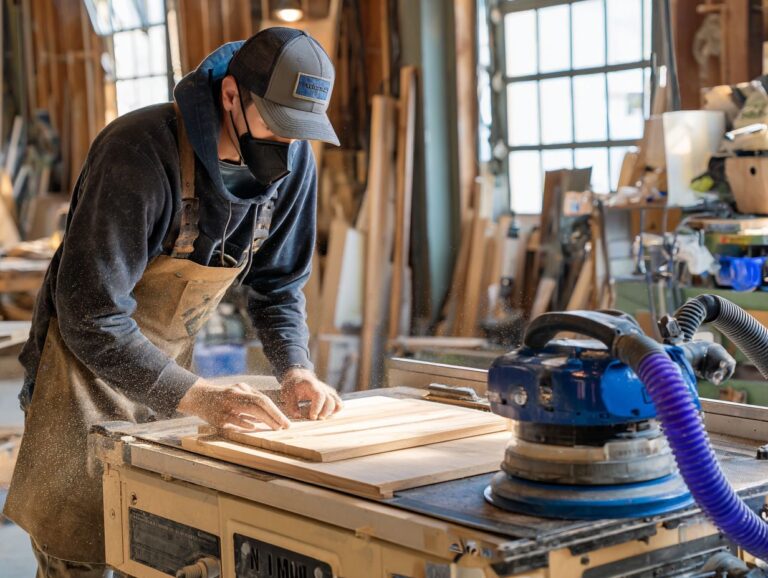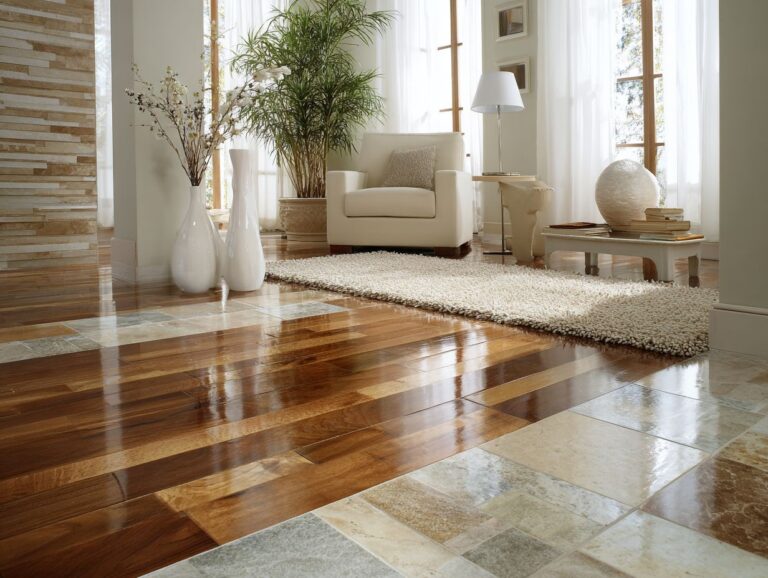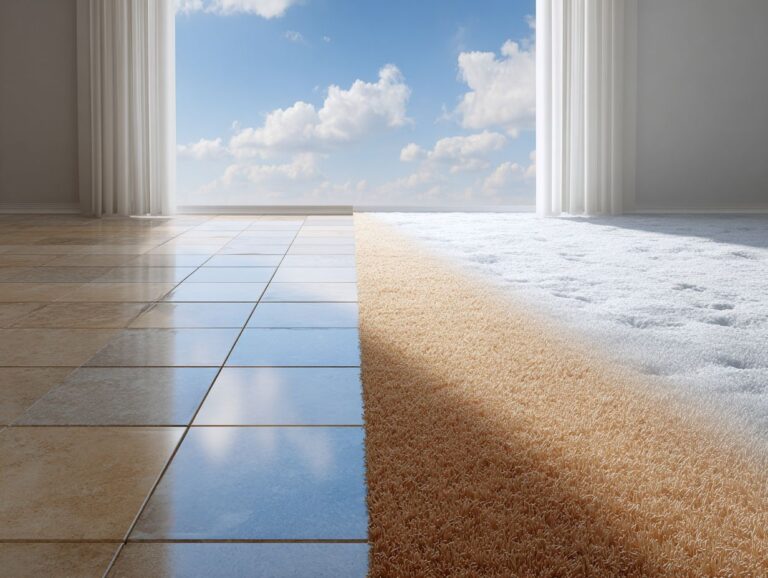Bedroom Flooring Ideas – Comfort and Noise Considerations
When choosing bedroom flooring, pick a type that feels good underfoot and helps reduce noise. Whether you prefer the warm touch of carpet or the natural structure of wood in low traffic areas, your design preferences matter. This article looks at different types of flooring to help you choose the right mix of style and practicality for your bedroom retreat. Prepare to change your space with imaginative and useful suggestions!
Key Takeaways:
Contents
- 2023 Popular Bedroom Flooring Options and Costs
- Soft Flooring Options
- Hard Flooring Options
- Luxury Vinyl and Tile Options
- Considerations for Flooring Installation
- Maintaining Comfort and Noise Control
- Frequently Asked Questions
- What are some comfortable bedroom flooring options?
- How can I reduce noise in my bedroom with flooring?
- Are hardwood floors comfortable for bedrooms?
- Can I use tile flooring in my bedroom?
- What is the best flooring for a child’s bedroom?
- How can I make my bedroom flooring more comfortable without replacing it?
Importance of Comfort and Noise Control
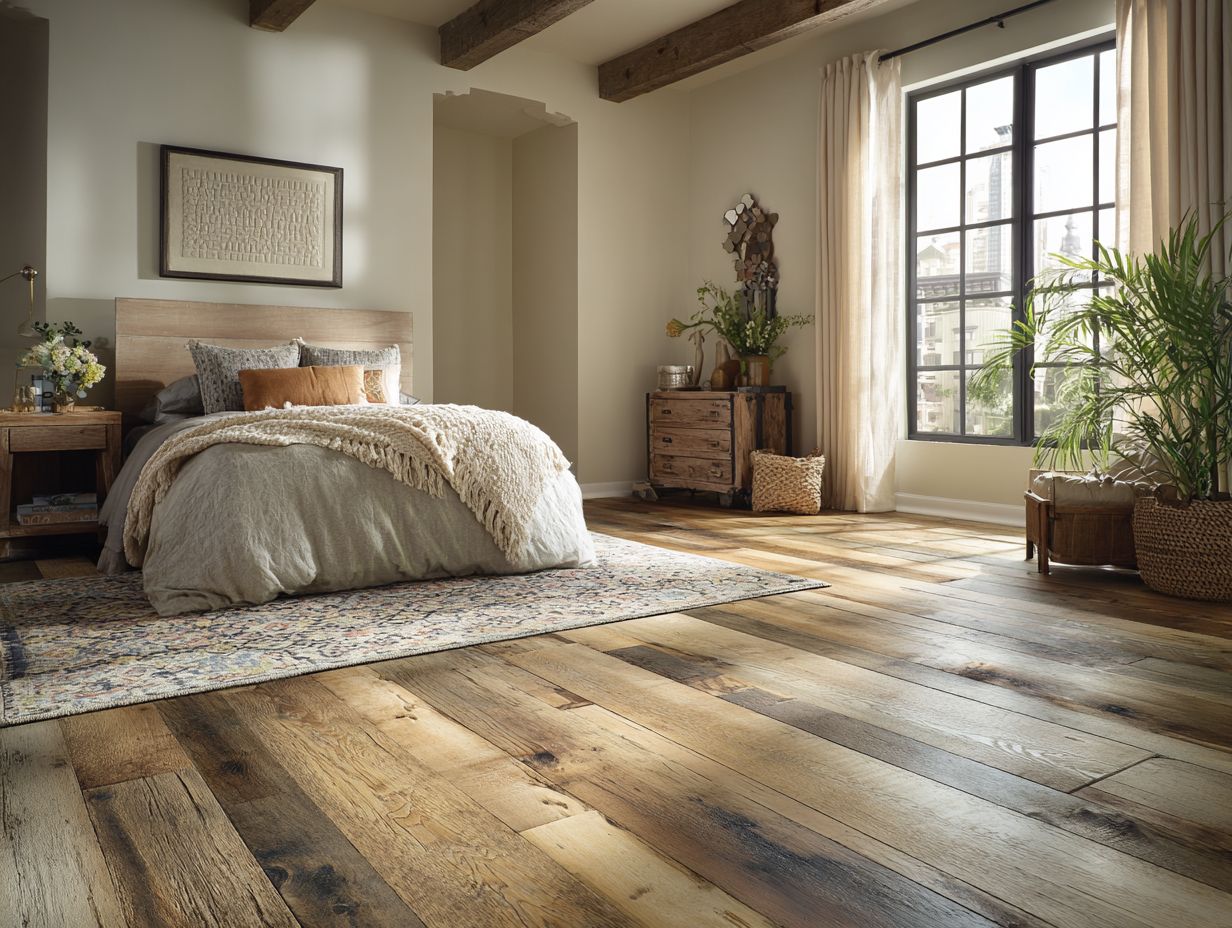
Comfort and noise control are paramount in bedroom flooring, influencing the overall ambiance and tranquility of your personal space.
Selecting the right flooring can improve comfort and help reduce noise.
For instance, carpet is often favored for its plush feel and exceptional noise-reducing qualities, effectively dampening footsteps and sounds from neighboring rooms.
Alternatively, cork flooring offers a unique balance of comfort and sustainability, providing a soft underfoot experience while also minimizing noise levels.
If you prefer hard surfaces, engineered hardwood with an underlay can also create a comfortable experience while absorbing some sound. Choosing these materials with care can change your bedroom into a peaceful haven.
Overview of Flooring Options
There are various flooring options to consider for bedrooms, each offering unique benefits and aesthetics, from luxurious vinyl to engineered wood.
Carpet is popular for its warmth and softness, often priced around $2 to $5 per square foot, but requires regular vacuuming and occasional professional cleaning.
Hardwood provides a timeless look and durability, usually costing $5 to $10 per square foot, though it may need refinishing over time.
Luxury vinyl tile is practical and water-resistant, easy to clean, with prices from $3 to $7 per square foot. For those interested in the durability aspects, you might want to explore our Vinyl Flooring Wear Layer – Thickness and Durability Guide.
Consider these factors based on your lifestyle and budget to choose the perfect bedroom flooring.
2023 Popular Bedroom Flooring Options and Costs
2023 Popular Bedroom Flooring Options and Costs
Flooring Options and Costs: Luxury Vinyl Cost
Flooring Options and Costs: Prevalence
The 2023 Popular Bedroom Flooring Options and Costs The dataset shows information about the prices and commonness of different flooring types, showing what’s popular in interior design and what buyers like. Looking at these numbers shows that luxury vinyl flooring has become a popular choice for homeowners who want something that looks good and is affordable.
Flooring Options and Costs emphasize the affordability and flexibility of luxury vinyl materials. Vinyl sheeting is the most budget-friendly option at $0.5 per square foot, appealing to cost-sensitive consumers while still offering durability and style. In contrast, luxury planks or tiles, priced at $5.0 per square foot Offer customers high-quality designs and improved textures that imitate natural materials such as wood or stone.
The cost variance between vinyl sheeting and luxury planks or tiles indicates a wide range of choices available to meet diverse budgetary constraints and design preferences. This versatility contributes to luxury vinyl’s popularity as it can mimic more expensive flooring types without the associated costs or maintenance challenges.
- Prevalence: The widespread use of Instagram by marketers and online stores further demonstrates the platform’s influence on consumer decisions. With 80% of Instagram marketers actively using the platform, and 86% of US, 81% of UK, and 75% of German online stores present on Instagram, the social media network is a significant driver in showcasing flooring options and influencing purchasing decisions.
The prevalence data highlights Instagram’s role as a key marketing channel for flooring retailers, where visual appeal and engagement strategies can effectively target consumers. Through Instagram, retailers can display flooring alternatives in real-life settings, enhancing consumer interest and driving sales.
Overall, the dataset shows the increasing popularity of luxury vinyl flooring, mainly because it is affordable and looks good in many styles. It shows how social media platforms like Instagram can be used to advertise flooring choices, influence consumer tastes, and help retailers with their marketing.
Soft Flooring Options
Soft floor coverings are comfortable and warm, making them popular for bedrooms, especially in places where people don’t walk often. .
Carpet
Carpet is a traditional option for bedroom floors, providing unmatched comfort and a soft texture underfoot.
When choosing carpet, consider pile height, which ranges from low-pile (1/4 inch) to plush options (over 1 inch) for different textures.
Materials like nylon, polyester, and wool each have unique benefits; for instance, nylon offers durability, while wool presents a soft, eco-friendly option.
Pricing typically varies from $2 to $5 per square foot, so set a budget. Area rugs can be placed in specific spots to match your decor, bringing extra texture and color to improve the room’s style.
Benefits of Carpet for Comfort
One of the key benefits of carpet is its ability to provide warmth and comfort, creating an inviting atmosphere in the bedroom.
Carpet makes rooms feel warmer, increasing comfort by 30% compared to harder surfaces like tile or wood.
For example, consider using a plush, medium-pile carpet in soft shades to create a soothing environment. Choosing a high-quality underlay further maximizes comfort and durability, adding sound insulation.
A well-planned bedroom with carpet, neutral bedding, and wooden furniture feels cozy and improves the look, creating an ideal place for relaxation.
Carpet Tiles
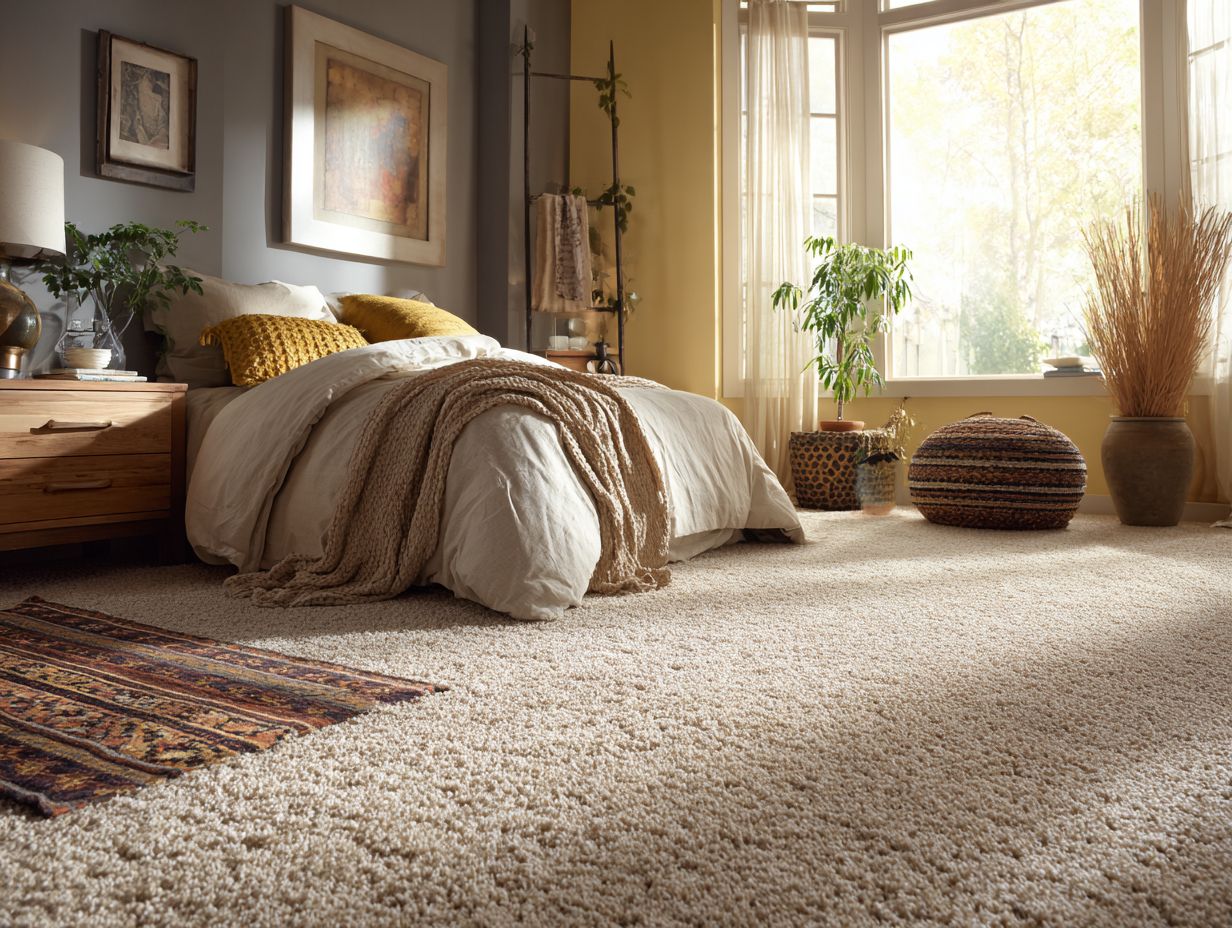
Carpet tiles are an innovative and practical flooring solution that offers both style and ease of maintenance for bedrooms.
These tiles come in sections you can put together yourself. Homeowners can easily create a professional appearance with little work. Simply adhere the tiles to a clean, dry surface, allowing for quick replacements if damage occurs.
To maintain their appearance, vacuum regularly and occasionally treat stains with mild soap.
Popular designs include:
- Solid colors
- Geometric patterns
- Textures like frieze or cut-pile
Offering a variety of options to improve the look of any bedroom. Carpet tiles can cost as little as $1.50 for each square foot, making them a cost-effective choice.
Noise Reduction with Carpet
Carpet absorbs sound well, reducing noise in the bedroom and making it more comfortable.
Research indicates that carpets can lower noise spread by up to 30%. Certain carpets have dB ratings between 50 and 55, which makes them very good at soundproofing.
To get the most out of this advantage, make sure to use high-quality padding underneath. For example, felt padding provides superior sound absorption compared to foam, further dampening impact noises.
When choosing your carpet, think about materials like nylon or wool. These materials are appealing and improve sound quality, making your bedroom peaceful and welcoming.
Hard Flooring Options
Hardwood and laminate floors are durable and provide a classic look that can improve the appearance of any bedroom. If you’re interested in enhancing this classic look further, you might explore our guide on hardwood flooring finishes like polyurethane, oil, or wax.
Hardwood Flooring
Hardwood flooring is a common choice because it looks good and is durable, appealing to homeowners seeking a classy appearance.
Among the popular options are oak, known for its strength and appealing grain patterns, typically priced between $5 to $8 per square foot, and maple, favored for its lighter color and fine texture, which can range from $6 to $10 per square foot.
The choice of wood significantly influences your bedroom’s design; for instance, oak’s pronounced grain adds a rustic charm, while maple’s subtle texture lends a modern elegance.
Consider your overall design theme when selecting hardwood to achieve a cohesive look.
Comfort Features of Hardwood
Modern hardwood flooring includes features that make it more comfortable, such as engineered wood choices that provide a warmer feel underfoot.
Engineered wood, due to its layered construction, offers superior insulation properties compared to traditional hardwood. This makes it an excellent choice for colder climates, as it retains heat more effectively.
When installed over radiant heating systems, engineered wood provides even warmth, ensuring a cozy environment. For optimal results, choose products designed for compatibility with radiant heat, such as those from brands like Kahrs or Mohawk.
This mix improves comfort and energy savings, creating an inviting space while reducing expenses.
Noise Considerations with Hardwood
While hardwood adds elegance to a bedroom, it’s essential to consider its sound properties, as it can transmit noise more readily than softer materials.
This transmission can make sounds up to 10 dB louder, which might disturb quiet times. To mitigate this, consider adding area rugs in key spots, such as under the bed or in seating areas, which can significantly dampen sound.
Installing a quality underlayment beneath your hardwood can absorb vibrations and decrease noise. Using products like cork or foam underlayment can make your bedroom flooring softer and help keep it warmer.
Laminate Flooring
Laminate flooring provides an affordable alternative to hardwood that mimics its appearance while being easy to maintain.
With costs ranging from $1 to $3 per square foot, laminate is a budget-friendly choice for homeowners. Its scratch and stain resistance makes it ideal for high-traffic areas.
Leading brands like Tarkett offer a variety of styles, including rustic oak and glossy walnut, allowing you to achieve the look of real wood without the maintenance hassles.
Putting it in is easy. Many use a snap-together setup that can be done yourself over a weekend.
Benefits and Drawbacks of Laminate
Laminate flooring is strong and cost-effective, but it has some negative aspects that need to be looked at.
A significant disadvantage of laminate flooring is that it can be noisy, so it is not the best choice for homes with multiple levels unless used with materials that reduce sound.
Although it is scratch-resistant, dropping pointed items on it can still cause harm. Comfort underfoot can also be an issue, especially during long periods of standing.
According to user testimonials, many appreciate the ease of cleaning but recommend area rugs to add warmth and cushioning.
Weigh these factors carefully against the visual appeal and cost-effectiveness of laminate.
Luxury Vinyl and Tile Options
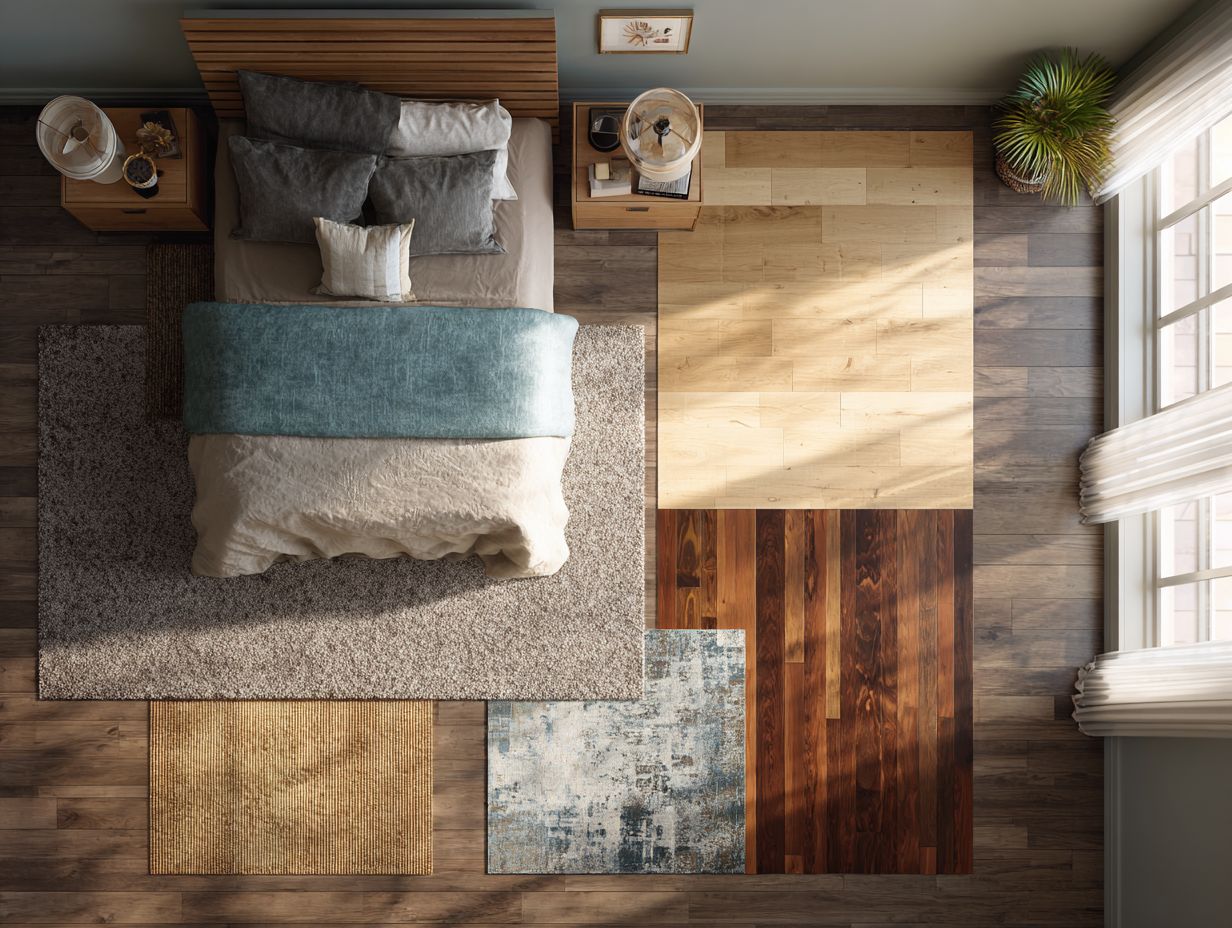
Luxury vinyl and ceramic tiles are a great option for bedroom flooring. They look good and help reduce noise.
Luxury Vinyl Plank (LVP)
Luxury Vinyl Plank (LVP) is a popular option for bedrooms, providing a fashionable appearance along with great strength and comfort.
The price for LVP usually ranges from $2 to $5 per square foot, which makes it a budget-friendly choice for flooring. It’s particularly water-resistant, which is ideal for homes with pets or children.
LVP comes in various designs, from wood-like textures to stone finishes, allowing you to match diverse decors.
For added comfort, consider installing it over radiant heating systems; this combination offers warmth underfoot during cold months, enhancing the overall experience in your bedroom.
Comfort and Noise Features of LVP
LVP is designed for comfort, with soft underfoot and sound-absorbing features that help create a serene bedroom environment.
Luxury Vinyl Plank (LVP) flooring consists of multiple layers that make it softer to walk on and help to lower noise levels.
For example, its padded layer helps lower sound from footsteps, keeping the bedroom quieter.
Brands like Starfloor Click offer LVP options that boast a sound reduction capability measured at 20 dB, effectively minimizing noise transfer between rooms.
Choosing products with built-in underlayment can improve sound absorption, leading to a quieter home.
Ceramic and Porcelain Tiles
Ceramic and porcelain tiles are durable flooring options that offer a wide range of designs suitable for modern bedrooms.
Ceramic and porcelain tiles are very durable and can handle a lot of use, making them ideal for high-traffic areas like bedrooms.
Ceramic tiles typically range from $1 to $5 per square foot, featuring various designs and textures such as glossy finishes or matte earth tones. Porcelain costs between $3 and $8 per square foot. It is durable and water-resistant, which makes it perfect for damp locations.
For decorative styles, consider:
- Patterned tiles for a focal point
- Large-format tiles for an expansive appearance
Both options are easy to clean, ensuring long-lasting beauty.
Impact on Noise Levels
While beautiful, ceramic and porcelain tiles can increase noise levels, which is an important consideration for bedroom design.
To mitigate noise issues, consider using area rugs or carpets, which can absorb sound and provide comfort.
Installing sound-absorbing underlayment beneath the tiles can significantly reduce sound transmission.
For a practical fix, select thick underlayment materials like cork or rubber. They reduce sound and improve heat insulation.
Incorporating textured wall hangings can further minimize acoustics, creating a peaceful retreat in your bedroom.
Considerations for Flooring Installation
Correctly installing flooring is important for comfort and function, and requires careful choice and application of materials. For those considering vinyl options, our deep dive into rigid core vinyl flooring offers valuable insights on its benefits and installation techniques.
Underlayment Options
Selecting the right underlayment is essential for enhancing sound absorption and comfort in any bedroom flooring installation.
The choice of underlayment largely depends on the flooring type.
- For laminate, high-density foam works well, typically costing around $0.30 to $0.60 per square foot, offering decent sound absorption with an IIC rating of approximately 50.
- In contrast, cork underlayment suits hardwood floors, priced between $0.90 and $1.50 per square foot, providing excellent sound reduction with STC ratings often above 60.
- If you’re putting in carpet, consider rubber padding, which improves sound reduction and comfort, usually costing between $1 and $2 per square foot.
Soundproofing Techniques
Using soundproofing methods can greatly improve the quietness and comfort of your bedroom.
- To achieve optimal noise reduction, consider using acoustic panels to absorb sound waves, heavy drapes to block external noise, and soundproof underlayment beneath floors.
Acoustic panels can reduce noise by up to 30%, making them ideal for walls and ceilings. Heavy drapes, particularly those made from dense fabrics, can lower sound transmission while also adding a decorative touch.
Meanwhile, soundproof underlayment can be particularly effective in apartments, reducing noise by about 25%, ensuring that both bedroom and neighboring units remain peaceful.
Maintaining Comfort and Noise Control
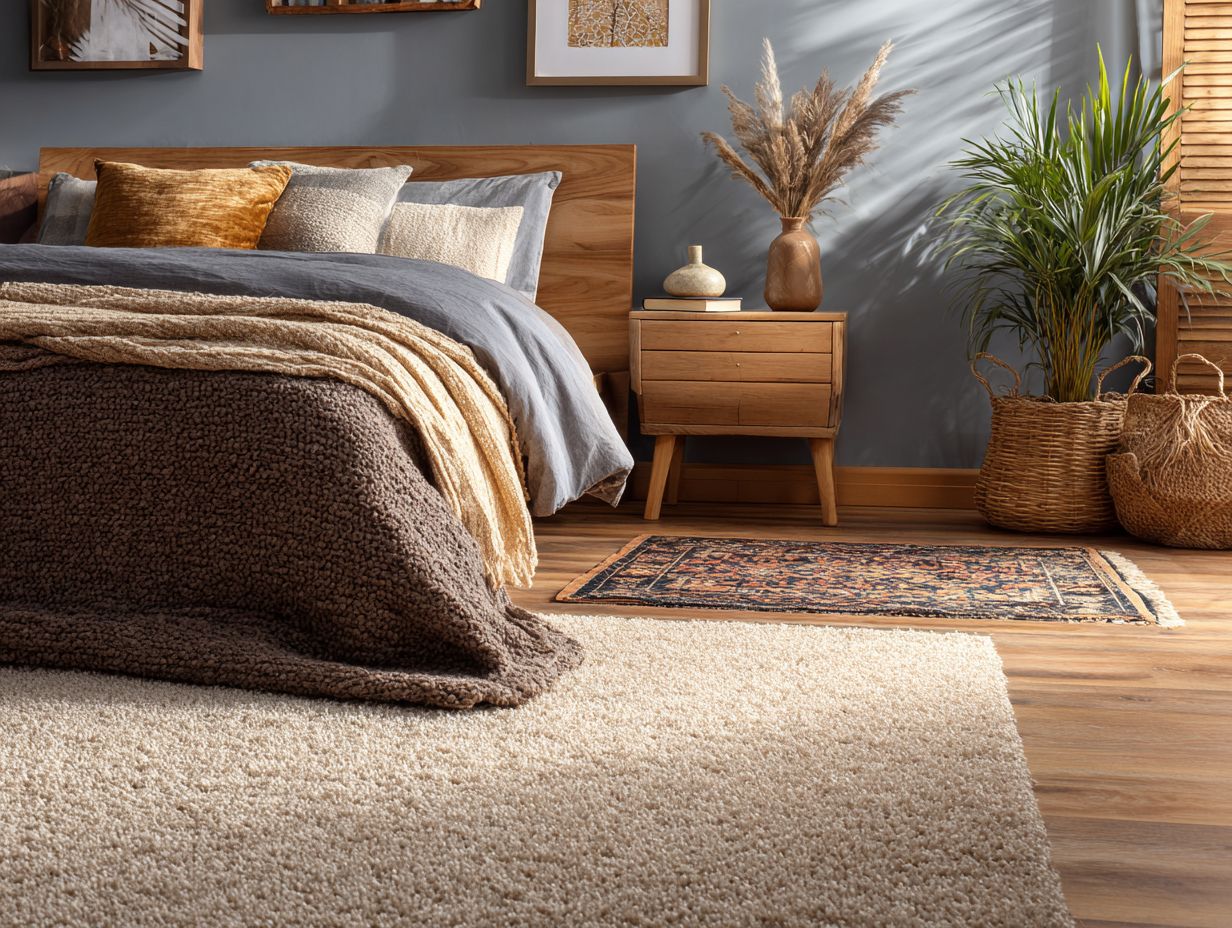
Taking care of your bedroom floor regularly is important for comfort and keeping noise down, no matter what kind of flooring you have.
Regular Maintenance Tips
Adopting a regular maintenance routine is essential for preserving the beauty and functionality of your flooring.
To keep your floors in top shape, follow these specific tips:
- Vacuum carpets at least once a week to remove dirt and allergens.
- For hardwood or laminate, use a microfiber mop with a damp solution, avoiding excess water.
- If you have luxury vinyl plank (LVP), a damp mop is recommended, but be sure to wring it out thoroughly.
Create a monthly checklist: deep clean carpets with a steam cleaner, check for scratches or damages on hardwood, and inspect grout lines for tiles. This routine keeps your flooring clean all year.
Choosing the Right Area Rugs
Area rugs are important for adding comfort and improving the look of bedrooms, offering both style and warmth.
When selecting an area rug, consider size first; it should complement your space without overwhelming it. For a queen bed, aim for a rug that extends at least 18 inches beyond the sides.
Materials like wool and cotton offer durability and softness, perfect for cozy environments. For added comfort, look for plush shag or a high-pile rug.
Persian and modern geometric patterns can improve your dcor and offer a touchable experience. Combine these elements to create a harmonious atmosphere that reflects your personal style.
Frequently Asked Questions
What are some comfortable bedroom flooring options?
Some comfortable bedroom flooring options include carpet, cork, and vinyl. These materials provide a soft and comfortable surface for walking, making them an excellent option for bedrooms.
How can I reduce noise in my bedroom with flooring?
To reduce noise in your bedroom, consider installing carpet, cork, or vinyl flooring. These materials have sound-absorbing properties which can help reduce noise from footsteps and other household activities.
Are hardwood floors comfortable for bedrooms?
Hardwood floors may not be as comfortable as other options, but they can still be a good choice for bedrooms. To make them more comfortable, consider adding area rugs or installing a soundproof underlayment beneath the flooring.
Can I use tile flooring in my bedroom?
Tile flooring is not typically recommended for bedrooms as it can be cold and uncomfortable to walk on. If you live in a warm area, think about using large, textured tiles that can provide comfort and insulation.
What is the best flooring for a child’s bedroom?
The best flooring for a child’s bedroom should be comfortable and durable. Consider options such as carpet, cork, or vinyl, which are soft and easy to clean. You may also want to consider installing a soundproof underlayment to help reduce noise.
How can I make my bedroom flooring more comfortable without replacing it?
If you’re not able to replace your bedroom flooring, you can make it more comfortable by adding area rugs and using furniture pads to cushion the floor. You can also consider using a thick, padded rug pad underneath your existing rug for added comfort.
